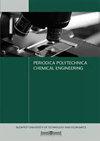Modified Layered Double Hydroxide Mg/M3+ (M3+ = Al and Cr) Using Metal Oxide (Cu) as Adsorbent for Methyl Orange and Methyl Red Dyes
IF 1.8
4区 工程技术
Q3 ENGINEERING, CHEMICAL
引用次数: 0
Abstract
Mg/Cr-layered double hydroxide (Mg/Cr-LDH) and Mg/Al-layered double hydroxide (Mg/Al-LDH) intercalated metal oxide (Mg/Cr-Cu and Mg/Al-Cu) were synthesized by the co-precipitation method which is indicated by the X-ray diffraction (XRD), Fourier-transform infrared spectroscopy (FTIR), and Brunauer Emmett Teller (BET) analysis. Mg/Cr-LDH intercalated metal oxide increased its surface area from 21.5 to 38.9 m2/g, while the surface area of Mg/Al-LDH from 23.2 to 30.5 m2/g. The adsorption capacity of Mg/Cr-Cu is 64.156 mg/g for methyl orange (MO) and 78.740 mg/g for methyl red (MR), and the adsorption capacity of Mg/Al-Cu is 97.087 mg/g for MO and 108.696 mg/g for MR. Equilibrium time on the adsorption process occurred at 90 minutes with adsorption kinetics followed by pseudo-second-order (PSO). The adsorption isotherm followed the Langmuir isotherm equation. Data of thermodynamic parameters indicate that the adsorption process in this study occurs spontaneously and endothermically. The regeneration results show that Mg/Cr-Cu and Mg/Al-Cu can be used for the 5 cycles regeneration process of MO and MR adsorption process. Interactions that occur between adsorbents and adsorbate include physical interactions, interactions with the involvement of hydrogen bonds, and electrostatic interactions.金属氧化物(Cu)作为甲基橙和甲基红染料吸附剂的改性层状双氢氧化物Mg/M3+ (M3+ = Al和Cr
采用共沉淀法合成了Mg/ cr层状双氢氧化物(Mg/Cr-LDH)和Mg/ al层状双氢氧化物(Mg/Al-LDH)插层金属氧化物(Mg/Cr-Cu和Mg/Al-Cu),并通过x射线衍射(XRD)、傅里叶变换红外光谱(FTIR)和Brunauer Emmett Teller (BET)分析进行了表征。Mg/Cr-LDH插层金属氧化物的比表面积由21.5 m2/g增加到38.9 m2/g, Mg/Al-LDH插层金属氧化物的比表面积由23.2 m2/g增加到30.5 m2/g。Mg/Cr-Cu对甲基橙(MO)和甲基红(MR)的吸附量分别为64.156 Mg/ g和78.740 Mg/ g, Mg/Al-Cu对MO和MR的吸附量分别为97.087 Mg/ g和108.696 Mg/ g,吸附过程的平衡时间为90 min,吸附动力学为准二阶动力学。吸附等温线符合Langmuir等温线方程。热力学参数数据表明,本研究中的吸附过程是自发的、吸热的。再生结果表明,Mg/Cr-Cu和Mg/Al-Cu可用于MO和MR吸附过程的5次循环再生过程。发生在吸附剂和吸附物之间的相互作用包括物理相互作用、氢键参与的相互作用和静电相互作用。
本文章由计算机程序翻译,如有差异,请以英文原文为准。
求助全文
约1分钟内获得全文
求助全文
来源期刊

Periodica Polytechnica Chemical Engineering
ENGINEERING, CHEMICAL-
CiteScore
3.10
自引率
7.70%
发文量
44
审稿时长
>12 weeks
期刊介绍:
The main scope of the journal is to publish original research articles in the wide field of chemical engineering including environmental and bioengineering.
 求助内容:
求助内容: 应助结果提醒方式:
应助结果提醒方式:


